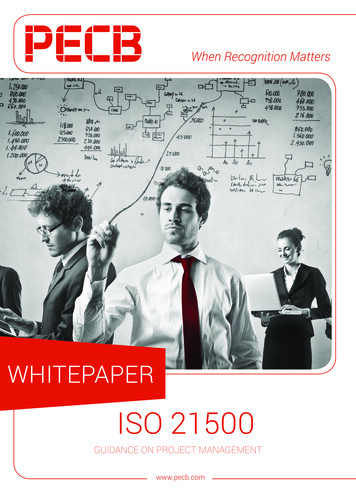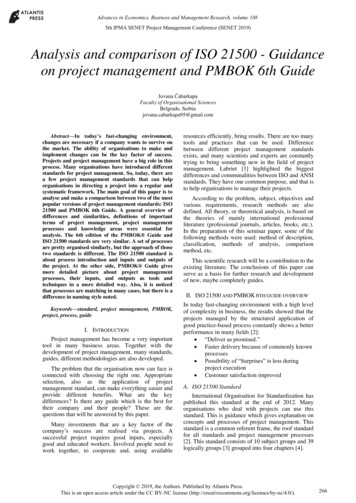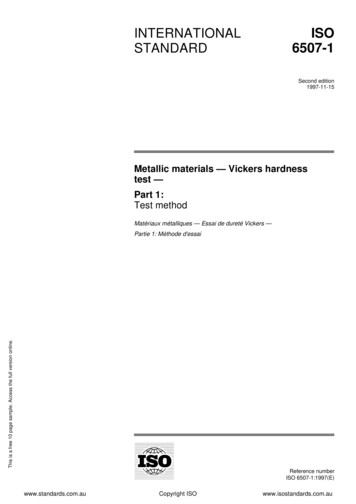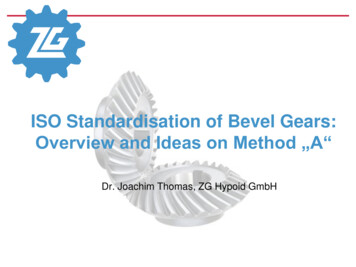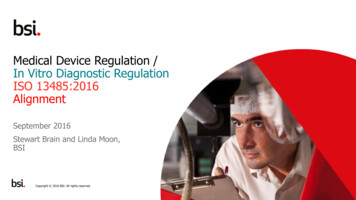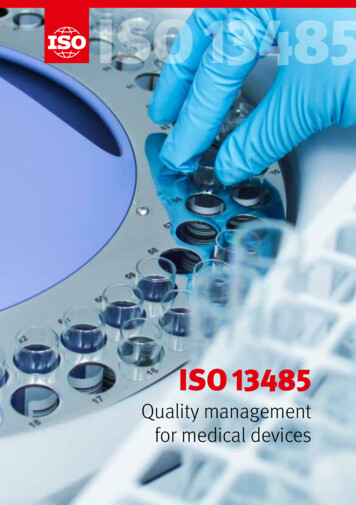
Transcription
Comparison between ISO 21500 andPMBOK Guide 5th Edition.Theoretical background and practical usage of ISO 21500 in IT projects.Katarzyna Wojnarkatarzyna.wojnar@wp.pl
Table of Contents1.Introduction . 31.1.2.Problem statement. 3ISO 21500 background and overview . 42.1.ISO organization. 42.2.The driver and development process of ISO 21500 . 43.Project definitions. 54.Project Management Processes . 55.4.1.Project Management Process Groups . 64.2.ISO 21500 Subject groups . 64.3.Structure of Processes . 74.4.Conclusion . 8Practical usage of ISO 21500 . 95.1.Additional benefits of ISO 21500. 106.Summary . 107.Literature and Internet sources . 112 Page
1. IntroductionLast two decades are the fastest time of changes in the companies in history. The ability of theenterprises to invent and implement changes in their operations is the key factor of company‘ssuccess. This is also time when the lack of ability to implement change can cause the financialand organizational troubles in the company. It is noteworthy, that the way of managing thecompany is changing very fast now and the success relays on the pace of adapting to thechanging environment. In the management, the trends of process management as well asproject management became very important and the idea of dealing with processes andprojects went into the highest level of Management.Project management is one of the key skill sets demanded by organizations around the world.Some facts: One-fifth of the world‘s GDP, or more than 12 trillion, will be spent on projects each yearin the decade 2010-2021. In the coming years many skilled project management practitioners will be leaving theworkforce due to retirement — a trend which will have a major strategic impact for over 60%of the organizations worldwide.1.1.Problem statementIn today‘s world, investments and organizational changes are realized via projects andprograms of related projects. For many of these projects a variety of disciplines and a mix ofinternal and external workers are involved. All these people need to cooperate in a properway, everyone has to carry out his/her tasks effectively and, at the same time, all this workmust be aligned and executed in a process-driven way. A great number of projectmanagement methods and practices exist. Who can apply these properly? Which methodshould be chosen in a multidisciplinary project? How does one communicate with thestakeholders? These questions do not have easy answers.3 Page
2. ISO 21500 background and overview2.1.ISO organizationISO (International Organization for Standardization) is the world‘s largest developer ofvoluntary International Standards. The organization was founded in 1947, and since then haspublished more than 19 500 International Standards covering almost all aspects of technologyand business. From food safety to computers, and agriculture to healthcare, ISO InternationalStandards impact all our lives. The ISO story began in 1946 when delegates from 25 countriesmet at the Institute of Civil Engineers in London and decided to create a new internationalorganization ‗to facilitate the international coordination and unification of industrialstandards‘. In February 1947 the new organization, ISO, officially began operations. Todaythey have members from 162 countries and 3 368 technical bodies to take care of standarddevelopment. More than 150 people work full time for ISO‘s Central Secretariat in Geneva,Switzerland.2.2.The driver and development process of ISO 21500In the past there have been a number of initiatives aimed at developing global projectmanagement standards, like Global Project Management Forum (from 1994), PMBOK Guide(ANSI standard, First Edition in 1996), Operational Level Coordination Initiative (OLCI,from 1999), Global Alliance for Project Performance Standards (GAPPS, from 2002) and ISO10006 – Quality management systems - Guidelines for quality management in projects, 2003).They all failed to produce one body of project management knowledge that was acceptedglobally. ISO 21500 – Guidance for project management is the step towards the true worldstandard for project management.In 2006 the British Standard Institute, a member of ISO, has initiated a request toward ISO towork on defining a standard for Project Management. ISO launched a new ISO projectcommittee ISO/PC 236, Project management. This committee started its activity in 2007 andhas already produced the ISO 21500 standard titled ―Guidance on Project Management‖. ISO21500:2012 was released on 10th of September 2012 and as of today, ISO 21500 is the fifthbest-selling ISO standard in the world (ISO 9001 is the best-selling standard).4 Page
After the release of ISO 21500, PC 236 became the permanent committee TC 258 and dealswith the creation of standards for ―Project, Programme and Portfolio Management‖. The nextstandard to be created by ISO TC 258 is for Portfolio Management. ISO 21500 is the first in aplanned family of project management standards. It is designed to align with relatedInternational Standards such as ISO 10006:2003, Quality management systems Guidelinesfor quality management in projects, ISO 10007:2003, Quality management systems Guidelines for configuration management, ISO 31000:2009, Risk management – Principlesand guidelines, and some sector-specific standards in industries such as aerospace and IT.3. Project definitionsThe PMI definition describes project as temporary endeavor undertaken to create uniqueproduct, service or result. The PM BoK Guide definition is probably the last one, that saysabout producing deliverables. According to ISO 21500 project is a unique set of processesconsisting of coordinated and controlled activities with start and finish dates, undertaken toachieve an objective. Achievement of the project objective requires deliverables conformingto specific requirements, including multiple constrains such as time, cost and resources.Products are absent from the ISO 21500 definition, however the uniqueness in bothdefinitions may be doubtful. When a project is initiated, the set of project processes is notdefined. According to ISO 21500 the set of project processes are defined because ofperforming process 4.3.3 Develop project plans, long after project initiation. So you do notknow whether this set of processes is unique (or have any other characteristics) when youinitiate a project. So if you strictly follow such definition, you may initiate something what isnot a project according to this definition.4. Project Management ProcessesThe PMBOK Guide 5th Edition gave the main idea for creation ISO 21500, so whenanalyzing ISO 21500 the associates to PMI are easy to identify.5 Page
4.1.Project Management Process GroupsISO 21500 the same as PMI divides the project processes into five process groups. There isonly slightly different naming of those:Table 1. Process groups in ISO 21500 vs. PMBOK Guide 5 th Edition4.2.ISO 21500 Subject groupsKnown from PMBOK Guide 5th Edition ―Knowledge Areas‖ evaluated into ―Subjects‖ inISO 21500, however they are called almost the same with minor change for ―Resource‖ vs.―Human Resources‖.Table 2. Subjects and Knowledge Areas6 Page
4.3.Structure of ProcessesThe structure of description of processes in ISO 21500 differs from that in PMBOK Guide.The main difference is that ISO 21500 does not provide description of tools and techniques.The description of each process in ISO 21500 consists of general description and a tablecontaining primary inputs and primary outputs. ISO 21500 descriptions are also substantiallyshorter than those of PMBOK Guide. In fact ISO 21500 describes 39 processes on 36 pagesof guidance for project management, where 47 processes of PMBOK 5th Edition arepresented on over 400 pages of the guide.Table 3. Processes of ISO 215007 Page
Table 4. Processes of PMBOK Guide 5th Edition4.4.ConclusionThe important consistency between the ANSI and the ISO standards will definitively help theprofession. PMI certifications will continue to promote structured project managers and theseproject managers (or associates) will definitively help a lot of organizations to align theirproject management processes toward ISO recommendation. This mutual contribution islikely to continue since a new technical committee has been set-up to deal with program andportfolio management. And the organization of this new committee is the same than thecommittee producing the ISO 21500 standard. This might also lead PMI to certify portfoliomanagers in the future PMI confirms its leading position to certify program managers,project managers and associates who will feel ―at home‖ in ISO oriented organizations. In thefuture, if ISO/DIS 21500 becomes the basis of a certification, there will be an advantage forcompanies to have PMI certified project and program managers onboard.8 Page
5. Practical usage of ISO 21500One can use the ISO 21500 guideline as follows: As a reference in an auditIf an organization‘s project management practice complies with the requirements and criteriaof ISO 21500, it has a good foundation for competent project managers to achieve properproject results. At the same time, the organization can prove both internally and externallythat it delivers quality projects, because they have based it on the independent standard.Indeed, this guideline does have direct influence on the project execution, but not on theproject result as such; As a link between different project management and business processesISO 21500 can supplement the ISO 9001 for quality management, especially in the area ofcontinuous improvement: realizing the necessary and wanted improvement processes inoperations with minimal disturbance of the production and service processes; As a checklist to prove the knowledge and skills of project managers and project workers inexecuting projectsThe guideline looks at one project at a time. It does not refer to more complex situations, likemulti-project management or sub-projects. This makes the guideline accessible for a broadtarget group, who can simply relate their own role to the guideline. ISO 21500 stronglyemphasizes the role that the environment plays during the execution of the project in order tomaximize the added value of the deliverables of the project; As a common reference (bridge function) between different methods, practices and modelsExisting project management methods like PRINCE2, collections of good practices like thePMBOK Guide, and competence models like ICB 3.0, provide an anchor to the projectmanager when running a project. A concise and clear guideline will attract parties that are notfamiliar with these existing methods, practices and models; As a common language in project managementISO 21500 bridges the differences and reinforces the similarities between the many partiesthat often work together in a project: sponsor, project manager and his colleagues, projectorganization, project workers, customers, users and/or the internal organization. ISO 21500supports the communication between the related parties by offering a common language. Acommon language is also essential with international and/or multi-disciplinary projects, wheredifferent teams work with different methods, and where cooperation is necessary. The9 Page
guideline can then be a binding factor by relating the processes and deliverables of thedifferent methods to those of ISO 21500.5.1.Additional benefits of ISO 21500Encourage transfer of knowledge between projects and organizations for improved projectdeliveryFacilitate efficient tendering processes through the use of consistent project managementterminologyEnable the flexibility of project management employees and their ability to work oninternational projectsProvide universal project management principles and processesKarl Best, Secretary of the project committee, comments: ―In an increasingly global economyproject managers need guidance to help them understand the basic principles of managingprojects. ISO 21500 can help those involved in projects improve the success of a wide varietyof project types.‖6. SummaryISO 21500:2012, Guidance on project management, can be used by any type of organization,including public, private or community organizations, and for any type of project, irrespectiveof complexity, size and duration.Project management is now big business. According to the Anderson Economic Group studycommissioned by the Project Management Institute, over 24.4 million employees wereparticipating in projects in 11 major economies in 2006. By 2016, this demand will exist tosupport 32.6 million employees in the same countries.ISO 21500 provides high-level description of concepts and processes that are considered toform good practice in project management. New project managers as well as experienced10 P a g e
managers will be able to use the project management guidance in this standard to improveproject success and achieve business results.Miles Shepherd, Chair of the ISO project committee that developed the new standard, states:―ISO 21500 enables people in any organization to understand how the discipline fits into abusiness environment. It is also intended to be used as a basic guide, aimed at the informedreader without an in-depth knowledge of project management.‖7. Literature and Internet sourcesANSI 2013, A guide to the project management body of knowledge (PMBOK Guide) 5th EditionLABINET T., STS: Comparing PMBOK Guide 4th Edition,PMBOK Guide 5th Edition, and ISO 21500REHACEK P.: Standards ISO 21500 and PMBOK Guide for Project ManagementZANDHUIS, A., STELLINGWERF R. 2013 ISO 21500 Guidance on Project Management. A Pocket Guide.http://www.sybena.pl/iso21500pmbok ang.htmhttp://www.slideshare.net/Robert emeeting-sweden/http://www.iso.org/iso/home.htm11 P a g e
Table 1. Process groups in ISO 21500 vs. PMBOK Guide 5th Edition 4.2. ISO 21500 Subject groups Known from PMBOK Guide 5th Edition ―Knowledge Areas‖ evaluated into ―Subjects‖ in ISO 21500, however they are called almost the same with minor change for ―Resource‖ vs. ―Human Resources‖. Table 2. Subjects and Knowledge Areas

